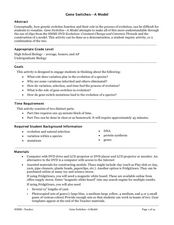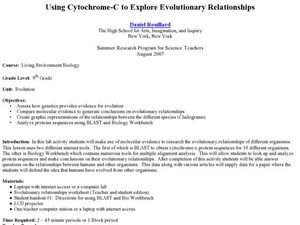Curated OER
A Problem in Satellite Synchrony
In this satellite synchrony worksheet, students use a spreadsheet or Least Common Multiples to solve 4 problems related to the satellite orbits, orbital periods and their synchronicity. Students determine when the satellites launched in...
Curated OER
Planetary Alignments
In this planetary alignments worksheet, students use 2 different methods to find out when planet alignments will occur. They use a three number series and they use least common multiples to find out when Mercury and Venus will align.
Curated OER
Solar Electricity ~ The Colour Sensitivity of a Photovoltaic Cell
Teacher's notes, a materials list, detailed procedure, tips, and extension ideas are all included to make teaching this lesson on photovoltaic cells a sunny spot in your day! After some brief background reading, physical science...
Curated OER
Adding and Subtracting Fractions
In this adding and subtracting fractions worksheet, students are guided through the process of adding and subtracting fractions and finding the least common denominator for fractions with different denominators. They practice adding and...
Curated OER
A Matter of Timing
In this orbital period activity, learners solve 2 problems about satellites and their orbits. They determine how many days it takes for two satellites to be in "opposition", they find the least common factor between their orbit periods...
Cornell University
Constructing and Visualizing Topographic Profiles
Militaries throughout history have used topography information to plan strategies, yet many pupils today don't understand it. Scholars use Legos and a contour gauge to understand how to construct and visualize topographic profiles. This...
Curated OER
An Inventory of My Traits
Students take an inventory of their own easily-observable genetic traits and
compare those inventories with other students in groups. They then make
data tables and bar graphs showing the most and least common traits in their group.
Curated OER
Investigating Factors That Affect Cell Membrane Permeability
Cell membranes and the factors that affect its integrity are studied, with Beet tissue used as the model. A poster to display findings of the permeability of the membranes would clarify understanding and also allow a layer of language...
Curated OER
Writing Ionic Formulas
In this ions worksheet, students use a table of common ions to determine how to write the chemical formula, using subscripts, to make a neutral compound. This worksheet has 44 problems to solve.
Curated OER
Entering The Twilight Zone
In this lesson plan sixth grade students get into groups and research a given ocean habitat. The major features of cold-seep communities are the objective but plenty information is given about other habitats which could be assigned to...
Multiverse
Rainbows of Light: The Visible Light Spectrum
Rainbows can teach us about the visible light spectrum. Learners observe multiple items that clearly display a rainbow to develop better connections. The lesson then explains wavelength using a rope to make waves.
Curated OER
Gene Switches- A Model
Students explore genetic variation within a population. In this genetic adaptation lesson, students investigate the reasons contributing to genetic adaptation. Students collaborate and analyze DNA models. Multiple resources are provided.
Curated OER
An Inventory of My Traits
In this biology activity, students identify and describe a number of easily observable genetic traits and compare the traits they have with other students. Then they identify and describe that some traits are common while others are not...
Discovery Education
Sonar & Echolocation
A well-designed, comprehensive, and attractive slide show supports direct instruction on how sonar and echolocation work. Contained within the slides are links to interactive websites and instructions for using apps on a mobile device to...
Curated OER
Math in the Wetlands Field Trip
Get your class out in the environment for hands on math activities. In this wetlands lesson, learners transplant native plants, calculate how much soil is needed, and perform math activities based on this experience. They then make...
Curated OER
Growing Caterpillars
Explore multiplication through caterpillar study. Learners will view a caterpillar video clip and work with a group to determine how much they would weigh if they grew to be 3,000 times their size as does the caterpillar. They will...
Curated OER
Ocean Impacts of an El Nino Event
Young scholars study sea surface height and temperature and other characteristics of an El Nino. In this ocean impacts lesson students examine the factors that influence an El Nino or La Nina.
Chicago Botanic Garden
Plant Phenology Data Analysis
Beginning in 1851, Thoreau recorded the dates of the first spring blooms in Concord, and this data is helping scientists analyze climate change! The culminating instructional activity in the series of four has pupils graph and analyze...
Curated OER
Using Cytochrome-C to Explore Evolutionary Relationships
Students analyze protein sequences. In this instructional activity on determining evolutionary relationships, students use the Internet tools BLAST and Biology Workbench to look at protein sequences. Students will compose an essay that...
Curated OER
Reading Chemical Formulas
Learners interpret basic chemical formulas. When class begins, students interpret a "chemical formula" for fruit salad. After they interpret the recipe, learners use the same strategies to identify chemical formulas. They evaluate the...
Alabama Learning Exchange
Action at Plate Boundaries
Students diagram the spreading of the ocean floor. In this earth science lesson plan, students read an article on plate boundaries of the ocean. Students are expected to diagram the oceanic convergent boundary, and give a written...
Curated OER
Molecular Evidence for Evolutionary Relationships
Students compare the amino acid sequences in cytochrome-c for a variety of organisms and use this information to infer evolutionary relationships. Students investigate the role of homeobox genes and what this indicates about the...
Curated OER
Unit Conversions
Eighth graders identify the different types of measurements and the instruments used to measure each type. After taking notes, they complete a bubble chart to examine the conversion between the units. To end the lesson, they practice...
Curated OER
Shadow Trackers: From Photography to Writing
Learners explore the rotation of the earth. In this science lesson, students view photos of various places around the world. Learners conduct an experiment in which they can see how the earth's rotation creates shadows on the earth.
Other popular searches
- Lcm and Gcf
- Math Least Common Multiples
- Hcf and Lcm
- Lcm Gcf
- Math Lcm and Gcf
- Least Common Multiple Lesson
- Lcm & Gcf
- Gcd and Lcm
- Cf and Lcm
- Cf Lcm
- Gcf Lcm Factor Trees
























